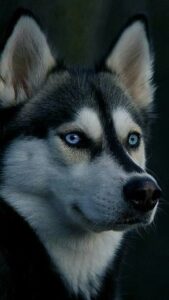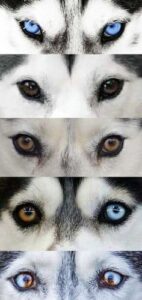Siberian Husky – Husky Dogs – Husky Price
Siberian Husky
Ek Husky is a medium-sized dog whose proportions suggest a perfect balance between power, speed and endurance. With its medium-length double-coat coat, erect ears and brush-type tail, this breed can present very diverse colors and spots, including white, with some specimens of notable color.
Measurements:
| Sex | Height | Weight | Time of life |
|---|---|---|---|
| Males | 53-56cm | 22-28kg | 11 to 15 years |
| Females | 51-54cm | 21-23kg | 12 to 16 years |
History

The Chukchi people are distinguished into two types, the nomadic and the sedentary.
The Siberian Husky saw the light among the latter, generally settled on the coasts of the Bering Sea, in the Arctic.
Therefore, due to their sedentary condition, the Chukchi were forced to breed dogs that could not only travel long distances to accompany men in their hunting and food supply parties, but also do so in the most energetically sustainable way. possible so as not to end up exhausted, since the final objective was to act as a transport vehicle to carry the load of food back to their settlements.

The genetic origin of this breed is still uncertain; However, evidence points to the possibility of a cross between jackal-type dogs and draft dogs imported from nearby tribes such as the Koryak and Kamchadal , which at some point may have been crossed with local arctic wolves, in an attempt to add certain traits. structural and adaptive to the environment, useful for the working dog they had in mind. Recent archaeological studies seem to partially support this theory.
DNA analysis of remains found in Siberia reveal that we are facing one of the oldest breeds of dogs in the world, even reaching dates that reveal us to be around 15,000 years old.
Because of this, the purity of the Siberian Husky has had to be genetically recovered up to two times and it is impossible to know exactly what they were like in their origins. However, we can verify that at least the dog bred today is the most similar to the first imports that were made from Siberia to the United States, thanks to the photography that already existed at that time.
Smaller in size, faster and with greater endurance than the common dogs (between 45 and 54 kg) generally used, the Siberians immediately dominated the race.
At that time, the females that were born were sacrificed at birth, and only those that showed great vitality managed to survive, since they were used for reproduction. The males that were born also had to pass an aptitude test, suffering the same fate as the females, since the Chukchi were very strict. Those chosen, on the other hand, were treated exceptionally, with the best care and the best food.
In January 1925, at –30°C, in the United States, a diphtheria epidemic dealt a severe blow to the city of Nome , Alaska . There the serum was insufficient to care for all those affected, and a great storm prevented the plane containing the medicine from taking off. A husky named Togo and all of his companions, including Balto , crossed the Bering Strait and brought the necessary serum. The feat lasted 127 hours over five days.
Today, many of the huskies registered in North America are descendants of the first dogs imported from Siberia in 1930 , having been trained by Leonhard Seppala. The origin of domestication is unknown.
Features:
It is a medium-sized, light-weight dog, despite what its appearance may suggest, almost the entire wingspan of a Siberian Husky is, in fact, purely fur. Below freezing point, the Siberian Husky has a dense coat. and thick, close to the body, never long (this characteristic known as Wooly Husky is a negative genetic mutation).
Like many other breeds with double-layered coats, and because even in Siberia there are also summer temperatures that exceed 24Cº, it is capable of drastically modifying its coat depending on the time of year or the general temperature of the place where it lives, making two large sheds of the wool that covers all their skin under the primary hair, up to twice a year. Generally in spring to face summer, and again in autumn to prepare for winter.
Colors:

Beyond the well-known black and white coat, the reality is that we are facing one of the races with the greatest diversity in terms of coat color, which can range from pure white to solid black (although it is true that There is almost always a small white mark somewhere on the coat). Going through colors such as gray, silver, red, sand, pinto, sable and agouti or chinchilla.
Eyes:

They can have brown, amber red, or blue eyes. It is possible to find specimens in which the eyes are of different colors, a phenomenon known as heterochromia , which may imply one eye of each color or even the same eye with two different colors (marble eye).
Personality:
 This breed is well known for its good nature and for being very affectionate with people, so they are not guard dogs by nature. They love it and need to be accompanied and should not be left alone for long periods of time as they can become very destructive. They like to be with other well-trained dogs, although they are agile and efficient hunters, so they must be trained carefully so that they can be in contact with other domestic animals. Although they do not usually bark, they do howl, sometimes just for the simple pleasure of doing so.
This breed is well known for its good nature and for being very affectionate with people, so they are not guard dogs by nature. They love it and need to be accompanied and should not be left alone for long periods of time as they can become very destructive. They like to be with other well-trained dogs, although they are agile and efficient hunters, so they must be trained carefully so that they can be in contact with other domestic animals. Although they do not usually bark, they do howl, sometimes just for the simple pleasure of doing so.
Origin:
This breed was already used by the Chukchis, a Paleosiberian people from the Kolyma River (Siberia) in the 19th century. The noble character of this breed could probably be attributed to the magnificent care it received from the Chukchis. As dog sleds were the primary means of transportation, huskies were of vital importance to the natives. The first Siberian Huskies arrived in Alaska in the early 20th century, where they are still known as Chukchis. Sled racing became popular and the speed of this breed amazed and inspired racing dogs in the United States. It was then that the Americans renamed this dog and called it the Siberian Husky.
Health
The Siberian Husky is usually a healthy and hardy breed. However, like many other breeds, they can suffer from inherited eye disorders and sometimes hip dysplasia (a disease that can cause mobility problems). Therefore, a hip and eye examination is important before dedicating the dog to breeding.
Exercise
This breed needs a lot of exercise, although it should be done in a safe and limited area, or on a leash, since they really want to run if left loose and do not usually respond to their owner’s call to return. It is essential to have a fenced garden and, as they can jump without taking a run, height is also an important factor. An adult Siberian Husky needs more than two hours of daily exercise.
Nutrition
Your dog’s diet should contain the proper proportion of all major nutrient groups. In addition, you should always have fresh water at your disposal. It is important to carry out regular checks to keep the dog in perfect shape and remember to feed it twice a day following the feeding guidelines of its specific food.
Cleanliness
Grooming is quite easy: normally it is enough to comb and brush it well two or three times a week, although during the shedding season you will have to brush it daily. The Husky is a very clean breed that has very little to no “dog smell.”
Best dog breeds for children
Although most dogs are traditionally good with children, all dogs and children need to be taught to get along and respect each other to be safe. Still, dogs and small children should never be left alone and adults should supervise all interactions between them.